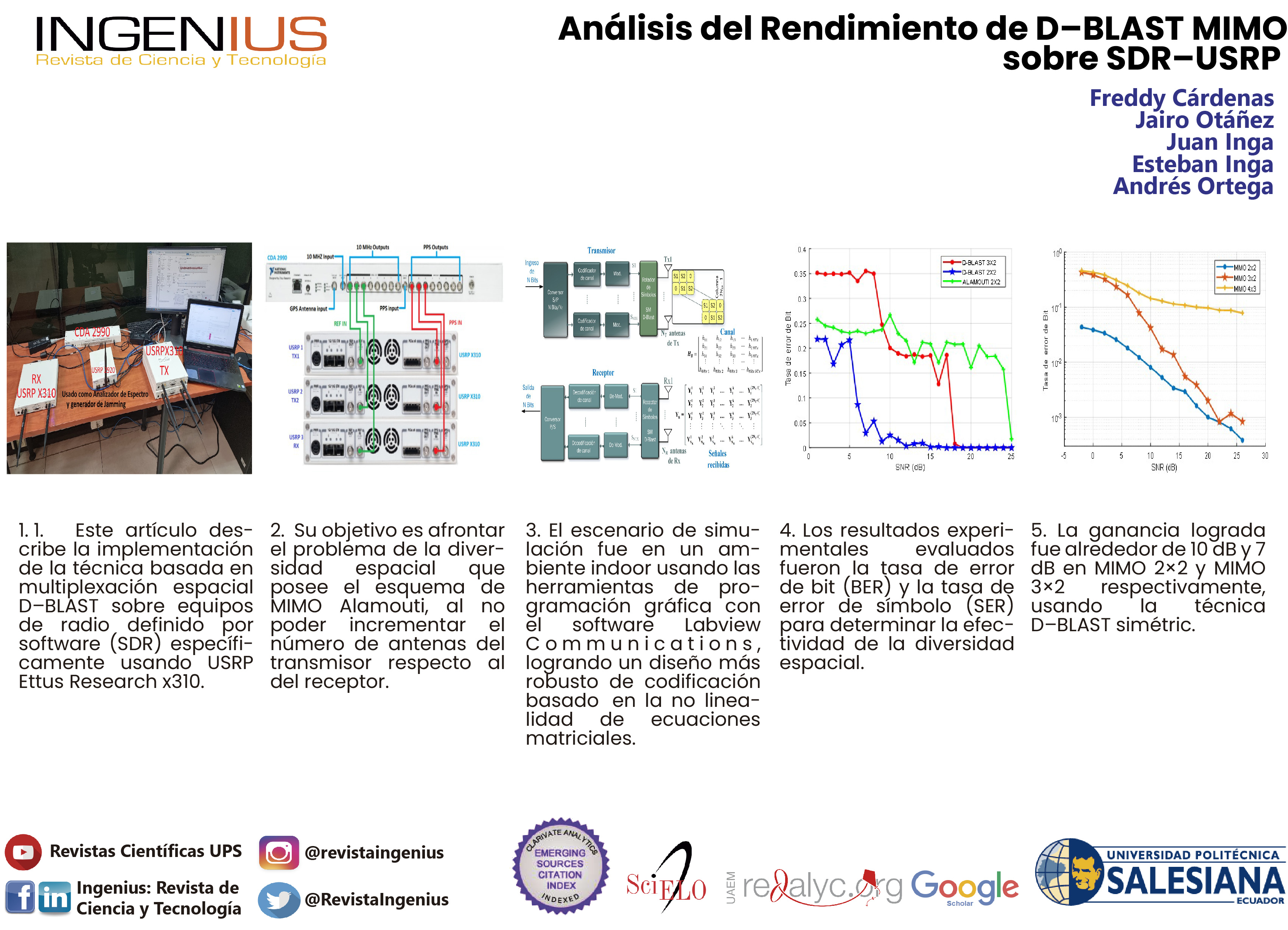D-BLAST MIMO Perfomance Analysis over SDR-USRP
Main Article Content
Abstract
Article Details
The Universidad Politécnica Salesiana of Ecuador preserves the copyrights of the published works and will favor the reuse of the works. The works are published in the electronic edition of the journal under a Creative Commons Attribution/Noncommercial-No Derivative Works 4.0 Ecuador license: they can be copied, used, disseminated, transmitted and publicly displayed.
The undersigned author partially transfers the copyrights of this work to the Universidad Politécnica Salesiana of Ecuador for printed editions.
It is also stated that they have respected the ethical principles of research and are free from any conflict of interest. The author(s) certify that this work has not been published, nor is it under consideration for publication in any other journal or editorial work.
The author (s) are responsible for their content and have contributed to the conception, design and completion of the work, analysis and interpretation of data, and to have participated in the writing of the text and its revisions, as well as in the approval of the version which is finally referred to as an attachment.
References
[2] M. Danneberg, N. Michailow, I. Gaspar, M. Matthe, D. Zhang, L. L. Mendesy, and G. Fettweis, “Implementation of a 2 by 2 MIMO-GFDM transceiver for robust 5G networks,” 2015, pp. 236–240. [Online]. Available: https://doi.org/10.1109/ISWCS.2015.7454336
[3] N. Prasad and M. K. Varanasi, “Analysis and optimization of diagonally layered lattice schemes for MIMO fading channels,” IEEE transactions on information theory, vol. 54, no. 3, pp. 1162–1185, 2008. [Online]. Available: https://doi.org/10.1109/TIT.2007.915701
[4] B. Clerckx and Claude Oestges, MIMO Wireless Networks. Academic Press Publications, 2013. [Online]. Available: https://doi.org/10.1016/C2010-0-66925-2
[5] Y. K. Chang, F. B. Ueng, and K. Z. Wu, “A novel MIMO-GFDM receiver for next generation communication,” Transactions on Emerging Telecommunications Technologies, vol. 29, no. 6, pp. 1–15, 2018. [Online]. Available: https://doi.org/10.1002/ett.3288
[6] M. Gupta and G. Murmu, “Experimental Study of Fading using Alamouti Space-Time Block Code,” no. 1. IEEE, 2018, pp. 0–5. [Online]. Available: https://doi.org/10.1109/SCEECS.2018.8546851
[7] A. Paulraj, R. Nabar, and D. Gore, Introduction to Space-Time Wireless Communications. Cambridge University Press, 2011, vol. 158. [Online]. Available: https://doi.org/10.1007/978-1-4419-6111-2_2
[8] O. Shental, S. Venkatesan, A. Ashikhmin, and R. A. Valenzuela, “Massive BLAST: An architecture for realizing ultra-high data rates for large-scale MIMO,” IEEE WIRELESS COMMUNICATIONS LETTERS, vol. 7, no. 3, pp. 404–407, 2017. [Online]. Available: https://doi.org/10.1109/LWC.2017.2780079
[9] J. J. Mroczek, M. J. Gans, and L. L. Joiner, “Performance of frequency hopping d-blast mimo architecture using ldpc and bpsk,” in MILCOM 2015-2015 IEEE Military Communications Conference. IEEE, 2015, pp. 860–865. [Online]. Available: https://doi.org/10.1109/MILCOM.2015.7357553
[10] A. Sibille, C. Oestges, and A. Zanella, MIMO: From Theory to Implementation. Academic Press Publications, 2010. [Online]. Available: https://bit.ly/3s2o9uk
[11] G. C. Daily and P. A. Matson, “Ecosystem services: From theory to implementation,” Proceedings of the National Academy of Sciences, vol. 105, no. 28, pp. 9455–9456, 2008. [Online]. Available: https://doi.org/10.1073/pnas.0804960105
[12] Y. Liu, B. Chen, J. J. Mroczek, J. E. Malowicki, and R. J. Michalak, “Robust mimo communications against antenna blockage and interference,” in MILCOM 2019-2019 IEEE Military Communications Conference (MILCOM). IEEE, 2019, pp. 7–12. [Online]. Available: https://doi.org/10.1109/MILCOM47813.2019.9020916
[13] V. Garg, “Fourth generation systems and new wireless technologies,” en. Wireless Communications & Networking. Elsevier, pp. 1–22, 2007.
[14] N. T. Hieu, N. T. Tu, L. T. Danh, A. N. Duc, and B. H. Phu, “Design and implementation of MIMO-STBC systems on FPGA hardware,” International Conference on Advanced Technologies for Communications, pp. 274–277, 2012. [Online]. Available: https://doi.org/10.1109/ATC.2012.6404275
[15] J. Kaderka and T. Urbanec, “Time and sample rate synchronization of RTLSDR using a GPS receiver,” in 2020 30th International Conference Radioelektronika (RADIOELEKTRONIKA), 2020, pp. 4–7. [Online]. Available: https://doi.org/10.1109/RADIOELEKTRONIKA49387.2020.9092398
[16] G. Soni, G. Kaur, and V. K. Banga, “Implementation & BER analysis of 2×2 MIMO Using USRP 2920- universal software radio peripheral,” in 2016 Second International Conference on Computational Intelligence Communication Technology (CICT). IEEE, 2016, pp. 523–527. [Online]. Available: https://doi.org/10.1109/CICT.2016.109
[17] V. S. Muradi, R. K. Paithane, A. Ahmed, and A. Pawar, “Spectrum sensing in cognitive radio using Labview and NI USRP,” in 2018 2nd International Conference on Inventive Systems and Control (ICISC). IEEE, 2018, pp. 1316–1319. [Online]. Available: https://doi.org/10.1109/ICISC.2018.8399019
[18] A. Yanza-Verdugo, C. Pucha-Cabrera, and J. Inga-Ortega, “Compressive Sensing Based Channel Estimator and LDPC Theory for OFDM using SDR,” Ingenius. Revista de Ciencia y Tecnología, vol. 23, no. 1, pp. 74–85, 2020. [Online]. Available: https://doi.org/10.17163/ings.n23.2020.07
[19] N. Narukawa, T. Fukushima, K. Honda, and K. Ogawa, “64 × 64 MIMO antenna arranged in a daisy chain array structure at 50 Gbps capacity,” in 2019 URSI International Symposium on Electromagnetic Theory (EMTS). URSI, 2019, pp. 2019–2022. [Online]. Available: https://doi.org/10.23919/URSI-EMTS.2019.8931517
[20] R. Prieto, A. Abril, and A. Ortega, “Experimental Alamouti-STBC Using LDPC Codes for MIMO Channels over SDR Systems,” in 2017 IEEE 30th Canadian Conference on Electrical and Computer Engineering (CCECE). IEEE, 2017, pp. 1–5. [Online]. Available: https://doi.org/10.1109/CCECE.2017.7946842
[21] V. Soria, G. V. Arevalo, P. Avila, F. Tello, and C. G. Santamaria, “Performance comparison of 2×2 and 4×4 V-BLAST and Alamouti MIMO systems,” in 2018 IEEE 3rd Ecuador Technical Chapters Meeting, ETCM 2018, 2018, pp. 18–21. [Online]. Available: https://doi.org/10.1109/ETCM.2018.8580317
[22] J. J. Anguís Horno, Redes de Área Local Inalámbricas: Diseño de la WLAN de Wheelers Lane Technology College. Escuela Superior de Ingenieros Universidad de Sevilla, 2008. [Online]. Available: https://bit.ly/3IFbsM9
[23] M. Sellathurai and S. Haykin, Space-Time Layered Information Processing for Wireless Communications. Wiley & Sons, 2009. [Online]. Available: https://bit.ly/3oPIjG3
[24] J. R. Hampton, Introduction to MIMO communications. Cambridge university press, 2013. [Online]. Available: https://bit.ly/3DQyhc2
[25] V. Puig Borrás, “Simulación computacional y paralelización de un sistema de comunicaciones inalámbrico MIMO: Estimación de canal y decodificación de señales,” Master’s thesis, Universidad Politécnica de Valencia, 2011. [Online]. Available: https://bit.ly/3IWlitc
[26] Y. S. Cho, J. Kim, W. Y. Yang, and C. G. Kang, MIMO-OFDM Wireless Communications with MATLAB. Wiley & Sons, 2010, vol. 11, no. 3. [Online]. Available: https://bit.ly/3m3QgFN

